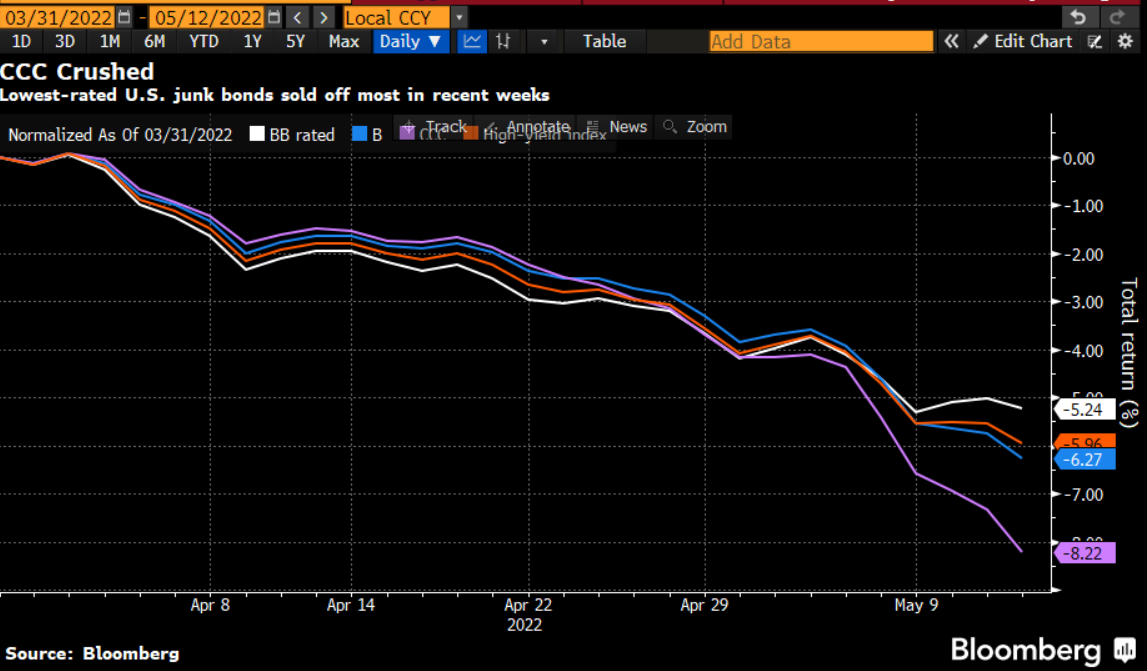Fund Flows & Issuance: According to a Wells Fargo report, flows week to date were $4.4 billion and year to date flows stand at -$49.1 billion. New issuance for the week was $0.7 billion and year to date issuance is at $71.2 billion.
(Bloomberg) High Yield Market Highlights
- U.S. junk bonds are headed toward the biggest monthly gains in more than a decade as the July rebound solidified after Chair Jerome Powell signaled that rate hikes would slow at some point and policy wasn’t pre-determined. The month-to-date return was 5.11%, the biggest since October 2011. Yields tumbled 98bps to close at a seven-week low of 7.91%, the first monthly drop in 2022.
- The U.S. high yield market shrugged off the 75bps increase in the benchmark US interest rate for the second straight month, and the warning by the central bank that “another unusually large increase could be appropriate at our next meeting, that is a decision that will depend on the data”.
- The riskiest segment of the junk bond market, CCCs, is poised for the biggest monthly advance since November 2020, with gains of 3.96% month-to- date.
- CCC yields plunged 75bps month-to-date to fall below 13% and close at 12.88%, the biggest monthly drop since December 2020 and also the first monthly decline in 2022.
- U.S. high yield investors flooded the asset class as the junk bonds reported a cash inflow of over $4 billion for the week. It was the biggest weekly intake since June 2020.
- The market appeared to interpret Chair Powell’s press conference as “dovish,” with futures pricing in a lower terminal rate than even the Fed’s own projections, Barclays strategists Brad Rogoff and Dominique Toublan wrote on Friday.
- Amid continuing macro uncertainty, the primary market has ground a near halt. The market priced a mere $1.8b, the slowest July since at least 2006.
- Year-to-date supply stood at almost $70b, the lowest since 2008.
(Bloomberg) Powell Signals More Hikes Coming, While Markets Detect Pivot
- Chair Jerome Powell said the Federal Reserve will press on with the steepest tightening of monetary policy in a generation to curb surging inflation, while handing officials more flexibility on coming moves amid signs of a broadening economic slowdown.
- Policy makers again raised the benchmark US interest rate 75 basis points on Wednesday to a range of 2.25% to 2.5% and said they anticipate “ongoing increases” will be appropriate.
- Just how much depends on how the economy performs, the central bank chief said. He stepped away from the specific guidance on the size of upcoming hikes he previously gave, though he didn’t take another jumbo move off the table.
- “While another unusually large increase could be appropriate at our next meeting, that is a decision that will depend on the data,” Powell said. “The labor market is extremely tight, and inflation is much too high.”
- Despite the whatever-it-takes message, markets staged a powerful rally with the S&P 500 stock index rising 2.6%, keying off Powell’s remarks that the pace of rate increases would slow at some point and that policy won’t be pre-determined.
- But Powell didn’t flag a pivot to lower rates or even a pause, according to Fed watchers, who argued there was a disconnect between what the central banker said and how markets responded.
- “We heard plenty of hawkish signals, including refusal to even contemplate that we are in a recession with strong job market gains and many references that restoring price stability is being prioritized over sidestepping a recession,” said Jonathan Millar, an economist with Barclays Plc. “Powell does not seem to be ruling out 100 or 75 basis-point hikes in September — it’s data dependent.”
- Central bankers are trying to tame the highest inflation in 40 years. Although the latest shift toward a more real-time approach to policy, Powell is trying to convey that the Fed will keep pushing borrowing costs higher as long as prices continue to jump too fast for comfort.
- Interest-rate markets are pricing a more benign hiking cycle than the Fed’s own June forecasts, which Powell pointedly said was the best current guide to the where officials see policy heading.
- Investors are betting that rates will peak around 3.3% this year before the Fed starts cutting modestly in 2023. Officials in June projected rates at 3.4% at year-end and 3.8% in December 2023.
- “By referencing the June Summary of Economic Projections he is not validating market pricing,” said Bloomberg’s chief U.S. economist Anna Wong. “The Fed is nowhere close to declaring victory over inflation.”
- In the post-meeting press conference, Powell was clear about the committee’s bias. “Restoring price stability is just something that we have to do,” he told reporters.
- “We do see that there are two-sided risks,” he said. “There would be the risk of doing too much and imposing more of a downturn on the economy than was necessary, but the risk of doing too little and leaving the economy with this entrenched inflation — it only raises the cost.”
- He said it wasn’t the committee’s intention to tip the economy into a recession, while noting that to achieve their 2% inflation goal slack would have to increase. That means unemployment would have to rise somewhat, while the economy would have to slow to below its full potential.
